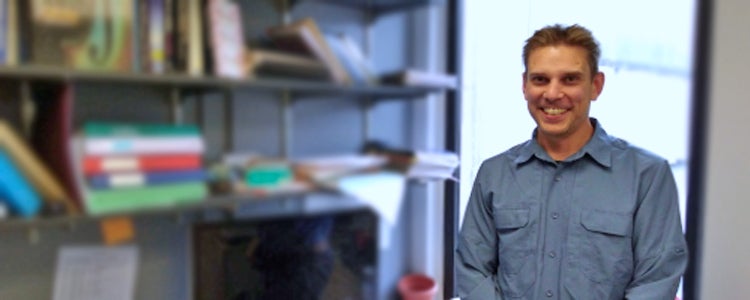 |
|
David Harmsworth, Applied Mathematics |
By Lisa Kabesh, Communications Associate, CTE
David Harmsworth, a Lecturer in the Department of Applied Mathematics, has known he wanted to focus on teaching since he made the jump from an undergraduate degree in the arts to focusing on mathematics two decades ago. A desire to make mathematics clear and accessible to his students, perhaps especially to those students who are studying math for degrees in other programs, is what animates this instructor’s teaching philosophy.
It’s a matter of “knowing your audience,” Harmsworth says. Since starting his career at Waterloo, Harmsworth has been tasked with teaching both engineering and mathematics students, and he notices a difference in how those two cohorts approach the subject. For engineers, he points out, math is largely a tool. It’s not the end goal. So when Harmsworth sets out to teach a course for engineering students, he shakes things up. In fact, he gets students working backwards. “I turn the theorem-proof, theorem-proof, theorem-proof style on its head,” says Harmsworth. Traditional mathematics textbooks begin with a theorem and then turn to the proof. Harmsworth starts with the proof and guides the students as they work deductively to arrive at the theorem. “They can see the theorem coming,” explains the instructor. Harmsworth sees this anticipation—this ability to observe and formulate potential solutions, or to approach mathematics from the perspective of a problem solver—as central to the relationship future engineers will have with mathematics.
Harmsworth calls this type of problem solving a form of intuition. “It’s about getting students to think about why things work the way they do,” he explains, “rather than memorizing and proving every step.”
The former linguistics major believes that his focus on clarity in communication is also a big help. When he wrote the course notes for his first-year calculus class, Harmsworth set out with the goal to “make calculus readable.” It looks like he has reached that goal—one student went as far as to call the course notes a “page turner,” likening them to a Sherlock Holmes novel. Like his lectures, Harmsworth’s course notes begin with a typical case or problem and position the reader as a problem solver—a detective, almost—who systematically puzzles through the problem to arrive at an applicable theorem. Here we can see the efficacy of Harmsworth’s “backwards” teaching method.
In our interview, Harmsworth also talked about where there is room for improvement in his teaching: getting more feedback from students as a term progresses. That he would mention student feedback comes as no surprise from an instructor who so clearly prioritizes the student perspective and clear communication of course outcomes. Many instructors have found success with mid-term feedback, one-minute papers, exit tickets, assessment as feedback, and early low-stakes assignments. We can’t wait to see what this linguistics-major turned mathematics instructor will try next.
Read more Teaching Stories
Tip Sheets
CTE has developed more than 100 Teaching Tips. Each one succinctly conveys useful ideas and practical methods for effective teaching. Some Teaching Tips relevant to the strategies mentioned in this Teaching Story include: